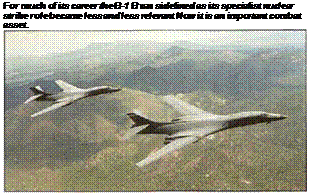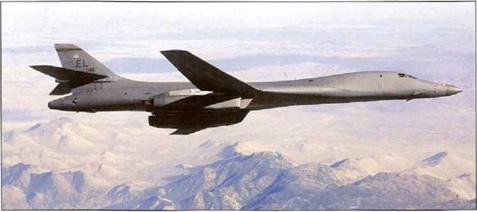Rockwell B-1 Lancer
|
|
S |
uffering one of the more protracted development periods of any recent military aircraft, today’s Rockwell B-1 В Lancer long-range multi-role strategic bomber is derived from the preceding B-1 A design. The R-1A programme was cancelled in 1977, and then resurrected in September 1981 with an order for 100 B-1 Bs. The design features a nlended low-wing/body configuration with VG outer wing panels and advanced high-lift devices, four GE Fi01 turbofans (mounted in pairs below the wing} with fixed intake geometry, a strengthened landing gear, three internal weapons bays, optional weapons bay fuel tanks for increased range, and external under fuselage stores stations for additional fuel or weapons. A moveable bulkhead in the forward weapons bay allows for the carriage of a diverse range of different sized weapons including ALCMs. The low-altitude, high-speed penetration role against sophisticated air defence systems was to be carried out using electronic jamming equipment, !R countermeasures, radar warning systems and the application of ‘low observable’ technology.
The offensive avionics system is centred around the AN/APQ-164 multi-mode radar, which includes a low-observable phased-array antenna for low-altitude terrain following and accurate navigation The
AN/ALQ-161A system is the core of the B-113*s continuously upgraded defensive capaoility.
The first production B-1 В flew on 18 October 1984. Deliveries began on 27 July 1985 with SAC achieving IOC exactly a year later. Today the Lancer equips three Air Combat Command and two ANG wings. Until 1991. the B-1 В was tasked w th the strategic role and is compatible with a variety of nuclear devices, which it can deliver over an unrefuelled range of approximately 12000 km (7,455 miles). A conventional munitions upgrade programme (CMUP) was begun in 1993, with block numbers denoting successive improvements. Block D is the current standard, allowing use of many precision weapons such as JSOW and WCMD (Wind-Corrected Munitions Dispenser), and Block F (to be completed in 2009) will see the defensive systems upgraded to meet the highest threat levels. The capacity for regular Mk 82 bombs is 84 in the three bomb bays and another 44 on the external pylons, which are rarely, if ever, used.
The B-1 saw its combat debut in Operation Desert Fox during December 1998, and later in 1999 against Yugoslavia in Operation Allied Force where over 100 sorties were flown and more than 5,000 Mk 82 bombs dropped.
 Specification: Rockwell B-1B Lancer Powerplant: four 36,92-kN (30,730 lb)
Specification: Rockwell B-1B Lancer Powerplant: four 36,92-kN (30,730 lb)
General Electric F101GE-102 turbofens Dimensions: wig span 41,67 m (136 ft 87 in) (at 15э] and 23.84 in (78 ft 27 in)(at 67° 30 ): length 44.81 m (1471t); height 10.36 m (34(110 in)
Weights: empty equipped 87G81 kg (‘=92.000 lb); maximum take-off 216365 <g(477.00C lb) Performance: maximum level speed a: high altitude about Mach 1.25 or (1324 kmh, 823 inpli); penetration speed at 61 m (200 It) more than 965 kmh (600 mph); range 12000 km (7,455 miles) with standard fuel Armament: maximum internal payload of 34020 kg (75.000 lb)












